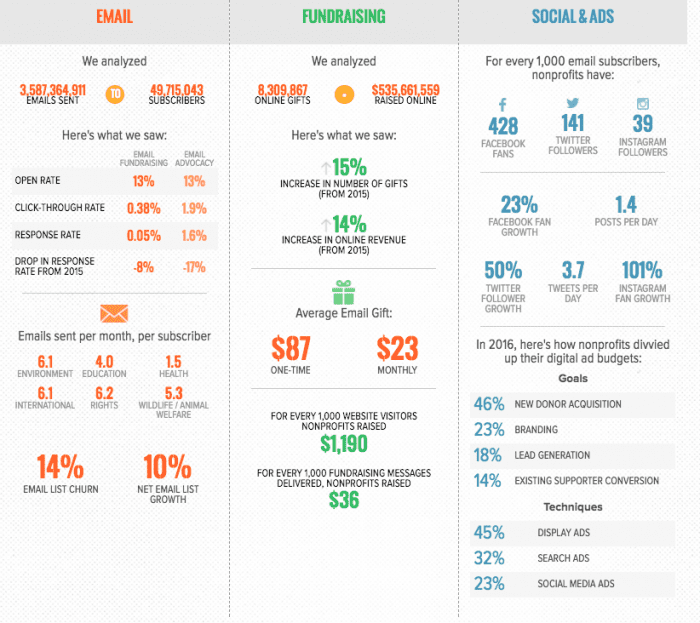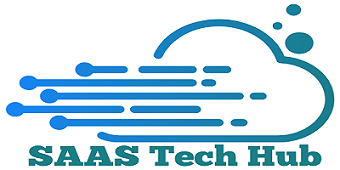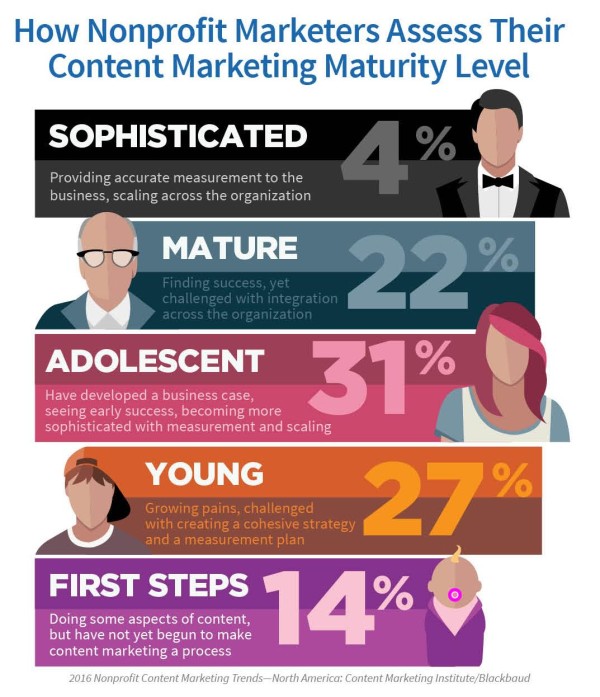Content marketing isn’t just for businesses seeking profit. Nonprofits can also benefit greatly.
Content marketing helps nonprofit organizations reach and engage supporters. It builds awareness, fosters trust, and inspires action. Sharing stories, updates, and causes through engaging content can attract donors and volunteers. It creates a strong online presence, essential for nonprofits in today’s digital age.
In this blog post, we’ll explore how nonprofits can leverage content marketing. We’ll look at strategies, tools, and success stories. This will help your nonprofit grow and make a bigger impact. Ready to boost your nonprofit’s reach? Let’s dive in!

Credit: www.smartinsights.com
Introduction To Content Marketing For Nonprofits
Content marketing is a powerful tool for nonprofits. It helps tell stories and engage supporters. Through strategic content, nonprofits can build awareness, drive donations, and inspire action.
Importance Of Content Marketing
Effective content marketing boosts your nonprofit’s visibility. It helps you reach a wider audience. Engaging content can turn casual readers into loyal supporters. It educates people about your mission and impact. Quality content fosters trust and builds community.
Content marketing is also cost-effective. With limited budgets, nonprofits need smart strategies. Regular blog posts, social media updates, and newsletters can make a big difference. Consistent content keeps your audience informed and involved.
How It Differs For Nonprofits
For nonprofits, content marketing is about mission-driven storytelling. Unlike businesses, nonprofits focus on values and causes. The goal is to inspire and mobilize supporters. Emotional stories and real-life examples resonate more.
Nonprofits often rely on volunteers and donors. Content must highlight the impact of their contributions. Clear calls to action are essential. Encouraging donations, volunteering, or sharing content can amplify your reach.
Transparency is crucial for nonprofits. Supporters want to see where their money goes. Detailed reports and success stories build credibility. Authenticity and honesty are key in nonprofit content marketing.

Credit: pinklemonadesocial.com
Setting Clear Goals
Setting clear goals is crucial for successful content marketing in the not-for-profit sector. Clear goals help you stay focused and ensure every action aligns with your mission. Let’s dive into defining mission objectives and aligning marketing strategies.
Defining Mission Objectives
Your mission objectives form the foundation of your content marketing plan. Start by asking yourself what you want to achieve. Are you aiming to increase awareness, drive donations, or recruit volunteers? Clearly defined objectives help in creating targeted content.
- Increase Awareness: Create content that educates and informs.
- Drive Donations: Share impactful stories and showcase needs.
- Recruit Volunteers: Highlight volunteer opportunities and experiences.
Write down these objectives. It gives clarity and direction to your content efforts. Each piece of content should serve a purpose aligned with these goals.
Aligning Marketing Strategies
Once you have clear objectives, align your marketing strategies accordingly. This ensures consistency and effectiveness in your efforts.
| Objective | Strategy |
|---|---|
| Increase Awareness | Use social media, blogs, and press releases. |
| Drive Donations | Implement email campaigns, landing pages, and donor stories. |
| Recruit Volunteers | Publish volunteer testimonials and event promotions. |
Ensure your strategies are measurable. Use analytics to track progress and make adjustments as needed. This helps in achieving your objectives effectively.
Identifying Target Audience
Understanding your target audience is crucial for effective content marketing, especially for non-profit organizations. Knowing who your donors, volunteers, and beneficiaries are can help tailor your messages and increase engagement. Let’s explore how to identify these key groups.
Understanding Your Donors
Donors are the lifeblood of many non-profits. To connect with them, you need to understand their motivations and preferences.
- Demographics: Age, gender, and location can provide insight into donor behavior.
- Interests: What causes do they care about? What other organizations do they support?
- Giving History: How frequently do they donate? What amounts do they typically give?
Collecting this data can help you create targeted campaigns that resonate with your donors. Use surveys, social media analytics, and donor databases to gather this information.
Engaging Volunteers And Beneficiaries
Volunteers and beneficiaries are essential to your non-profit’s success. Understanding their needs and motivations can help create more meaningful interactions.
| Group | Needs | Motivations |
|---|---|---|
| Volunteers | Training, appreciation | Making a difference, community involvement |
| Beneficiaries | Services, support | Improving their lives, overcoming challenges |
Knowing what motivates your volunteers can help you retain them and keep them engaged. Recognize their efforts and provide the training they need to succeed.
For beneficiaries, understanding their needs allows you to offer better services and support. This makes your non-profit more effective and impactful.
Creating Compelling Content
Creating compelling content is crucial for not-for-profit organizations. It helps in engaging supporters and spreading the mission. Quality content can inspire donations, volunteerism, and partnerships. Let’s explore some key techniques to make your content stand out.
Storytelling Techniques
Storytelling is a powerful way to connect with your audience. Share real-life stories that highlight your organization’s impact. Use emotional appeals to draw readers in. Present challenges and how your organization has addressed them. This method shows the human side of your mission.
Keep your stories simple and relatable. Focus on one person or event at a time. This makes it easier for readers to understand and feel connected. Use quotes and testimonials to add authenticity. Always end with a call to action that encourages readers to get involved.
Visual And Multimedia Content
Visual content grabs attention and makes information easier to digest. Use high-quality images, infographics, and videos to tell your story. These elements can showcase your efforts and achievements. They also make your content more shareable on social media.
Short videos can be very engaging. They provide a quick overview of your work. Use them to highlight events, interviews, or behind-the-scenes footage. Infographics are great for presenting data in a visually appealing way. They can simplify complex information, making it easier to understand.
Consistent branding in your visuals helps build recognition. Use your organization’s colors, logo, and fonts. This creates a cohesive look across all your content. It makes your materials instantly recognizable to your audience.
Utilizing Social Media
Nonprofits can effectively use social media for content marketing. Share stories and updates to engage supporters and raise awareness.
Nonprofits can benefit greatly from social media. These platforms help to raise awareness, engage supporters, and drive action. With limited resources, nonprofits must use social media efficiently. This section will explore the best platforms and campaign ideas for nonprofits.Best Platforms For Nonprofits
Facebook is ideal for nonprofits. It has a large user base. It offers fundraising tools. You can share updates, events, and stories. Engage with followers through comments and messages. Twitter is great for real-time updates. Use it to share news and join conversations. Engage with influencers and partners. Keep tweets short and to the point. Instagram is perfect for visual storytelling. Share photos and videos of your work. Use Stories to show behind-the-scenes content. Engage with followers through comments and direct messages. LinkedIn is useful for professional networking. Connect with donors, partners, and volunteers. Share updates and articles related to your mission. Join relevant groups to expand your reach.Social Media Campaign Ideas
Host a virtual event. Use Facebook Live or Instagram Live. Share updates and engage with your audience. Promote the event across all platforms. Create a social media challenge. Encourage followers to participate. Use a specific theme related to your mission. Share user-generated content to boost engagement. Run a fundraising campaign. Use Facebook’s fundraising tools. Set a clear goal and timeline. Share progress updates and thank donors publicly. Share success stories. Highlight the impact of your work. Use photos, videos, and quotes from beneficiaries. Make your followers feel part of the success. Ask for feedback. Use polls and surveys on Twitter or Instagram Stories. Engage your audience by asking their opinions. Use the feedback to improve your efforts. Post educational content. Share facts, tips, and resources related to your cause. Educate your audience about your mission. Use infographics and short videos for better engagement. “`Email Marketing Strategies
Email marketing can be a powerful tool for not-for-profits. With the right strategies, you can engage your audience, share your mission, and drive support. Let’s explore key strategies to make your email marketing effective.
Building An Email List
Creating a strong email list is the first step. Here are some effective tactics:
- Sign-up Forms: Place them on your website’s homepage.
- Social Media: Encourage followers to join your email list.
- Events: Collect emails at events and webinars.
- Partnerships: Collaborate with other organizations.
Ensure you have permission before adding someone to your list. This builds trust and reduces spam complaints.
Crafting Effective Newsletters
Newsletters keep your audience informed and engaged. Here’s how to make them effective:
- Subject Lines: Keep them short and interesting.
- Content: Share stories, updates, and ways to get involved.
- Design: Use a clean layout with images.
- Personalization: Address your reader by name.
- Call to Action: Include clear actions like “Donate Now”.
Track the performance of your newsletters. Adjust based on open rates and feedback.
| Strategy | Description |
|---|---|
| Sign-up Forms | Easy-to-find forms on your website. |
| Social Media | Promote your email list on social platforms. |
| Events | Collect emails at physical or virtual events. |
| Partnerships | Work with other groups to expand your reach. |
Using these email marketing strategies can help your not-for-profit grow. Build a strong list and send engaging newsletters. Your audience will stay informed and connected to your mission.
Measuring Impact And Success
Non-profit organizations often rely on content marketing to spread their message. But how do you measure the impact of your efforts? Understanding the success of your campaigns is crucial. This helps to ensure your resources are used effectively.
Key Performance Indicators
Key Performance Indicators (KPIs) are essential metrics. They help you track the performance of your content marketing. Here are some important KPIs for non-profits:
- Website Traffic – Measures the number of visitors to your website. A higher number indicates better reach.
- Engagement Rate – Includes likes, shares, and comments. It shows how your audience interacts with your content.
- Email Open Rates – Tracks how many recipients open your emails. Higher rates suggest effective email campaigns.
- Donations and Sign-ups – Measures the number of donations or sign-ups. It shows the direct impact of your content.
- Social Media Followers – Tracks the growth of your social media audience. More followers mean a wider reach.
Tools For Analytics
Using the right tools can help you analyze your content marketing efforts. Here are some effective tools for non-profits:
- Google Analytics – Provides detailed insights into your website traffic. It helps you understand your audience’s behavior.
- Hootsuite – Manages and analyzes social media campaigns. It helps track engagement and reach on various platforms.
- Mailchimp – Analyzes email marketing campaigns. It provides data on open rates, click rates, and more.
- HubSpot – Offers comprehensive analytics. It tracks website traffic, social media, and email campaigns.
- Sprout Social – Focuses on social media analytics. It helps monitor engagement and audience growth.
These tools provide valuable data. This data helps non-profits refine their strategies. It ensures their content marketing efforts are effective.
Case Studies And Examples
Content marketing is a powerful tool for nonprofits. Sharing stories, goals, and impacts can inspire people to support your cause. In this section, we will explore real-life examples of successful nonprofit campaigns. These case studies will highlight key strategies and lessons learned.
Successful Nonprofit Campaigns
Charity: Water is a well-known example. Their campaign focused on storytelling. They shared videos of communities receiving clean water. This visual content created an emotional connection. As a result, they raised millions of dollars.
Another example is World Wildlife Fund’s (WWF) Earth Hour. The campaign encouraged people to turn off their lights for one hour. This simple action raised awareness about climate change. WWF used social media to spread the message. The campaign went viral, reaching millions worldwide.
Save the Children launched a powerful campaign called “Most Shocking Second a Day.” They created a video showing a child’s life during war. The video was shared widely on social media. It raised awareness and funds for children in conflict zones.
Lessons Learned
These campaigns share common strategies:
- Storytelling: Personal stories create emotional connections.
- Visual Content: Photos and videos engage audiences.
- Social Media: Platforms help spread the message quickly.
- Simple Actions: Easy tasks can involve more people.
By focusing on these strategies, nonprofits can create effective content marketing campaigns. Learning from these examples can help your organization achieve its goals.
Future Trends In Nonprofit Marketing
The landscape of nonprofit marketing is evolving rapidly. New trends are emerging that can help nonprofits connect better with their audience. Staying updated with these trends is crucial for success.
Emerging Technologies
Technology is transforming how nonprofits reach their audience. Virtual reality can create immersive experiences for donors. Artificial intelligence can personalize communication with supporters. Blockchain can ensure transparency in donations.
Social media platforms offer live streaming features. These features allow real-time engagement with followers. Nonprofits can share events and updates instantly. This real-time connection helps build trust and engagement.
Adapting To Changing Landscapes
The digital landscape is always changing. Nonprofits need to adapt quickly. Mobile optimization is essential. Many users access content through their phones. A mobile-friendly website is a must.
Content should be easy to read on small screens. Short videos and infographics work well. Engaging visuals can capture attention. Email marketing remains important too. Personalized emails can increase engagement rates.
Social issues and donor expectations are evolving. Nonprofits should stay aware of these changes. Aligning with current social movements can attract more support. Transparent and ethical practices build donor trust.

Credit: contentmarketinginstitute.com
Frequently Asked Questions
What Is Content Marketing For Nonprofits?
Content marketing for nonprofits involves creating and sharing valuable content to engage and attract supporters. It helps raise awareness, promote events, and drive donations. By providing relevant and interesting content, nonprofits can build trust and foster a loyal community.
Why Is Content Marketing Important For Nonprofits?
Content marketing is important for nonprofits because it helps increase visibility and engagement. It allows nonprofits to share their mission, stories, and impact. This can attract more supporters, volunteers, and donors, ultimately helping the organization achieve its goals.
How Can Nonprofits Create Effective Content?
Nonprofits can create effective content by understanding their audience and addressing their interests. They should share compelling stories, use visuals, and provide valuable information. Consistency in posting and engaging with the audience is key to maintaining interest and support.
What Types Of Content Should Nonprofits Produce?
Nonprofits should produce various content types, including blog posts, videos, infographics, and social media updates. Sharing success stories, event promotions, and educational content can engage the audience and encourage support. Diverse content keeps the audience interested and informed.
Conclusion
Content marketing can greatly benefit not-for-profits. It builds trust and community. Sharing meaningful stories connects donors with your mission. Consistent, valuable content keeps supporters engaged. Use social media for wider reach. Regular updates show transparency and progress. Collaborate with influencers to expand your audience.
Measure success with analytics. Refine strategies based on data. Stay true to your cause and message. Content marketing helps not-for-profits thrive.


